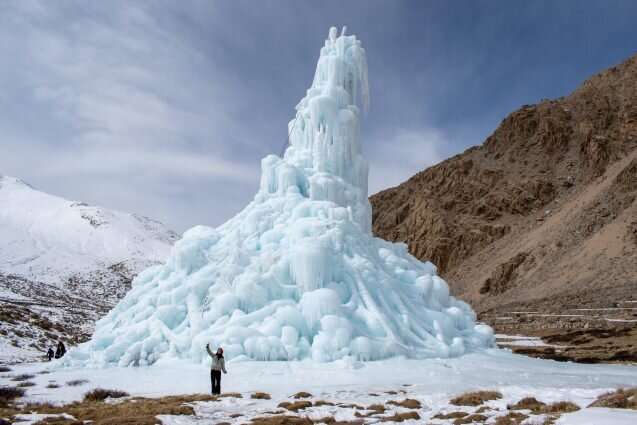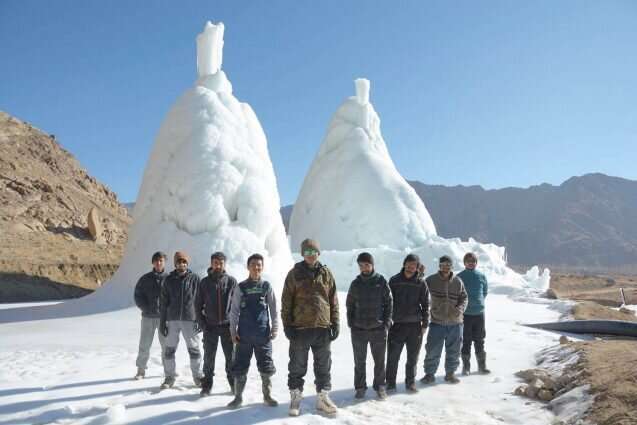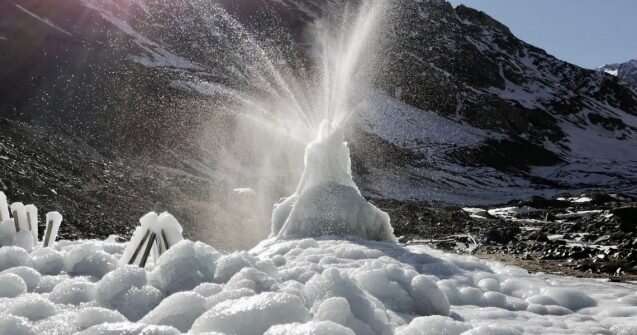This article has been reviewed according to Science X's editorial process and policies. Editors have highlighted the following attributes while ensuring the content's credibility:
fact-checked
trusted source
proofread
Ice stupas have become a popular water management tool in the Himalayas, but can they work in Chile?

Every winter across the Himalayas for decades, human-made reservoirs have been capturing glacial meltwater from streams and preserving it in the form of ice. By slowing meltwater down or spraying it into the air, people cause it to refreeze, often into shapes called stupas, after the domed Buddhist shrines they may resemble. The ice can then be melted the following year, allowing for irrigation that supports longer agricultural seasons in high mountainous areas.
Now, a group of Chilean engineers is attempting to transfer this technology to their country's high mountain glaciers in what they call the Nilus Project. In 2021 the engineers developed their first prototype in a private park in the Cajón de Maipo area south of Santiago, the nation's capital. The area was chosen due to both easy access and its proximity to the Maipo, a glacier-fed river descending from the Andes that provides fresh water for Santiago and the surrounding region. During the 2021 Southern Hemisphere winter, their prototype gathered 550,000 kilograms of ice that melted in just under two months. While smaller than the reservoirs in the Himalayas, it offers an early proof of concept.
These efforts caught the attention of University of Pennsylvania researcher Kristina Lyons, who read about the project while she was doing anthropological research on Indigenous Mapuche communities and their relationship with surrounding glaciers around Santiago.
"I was totally fascinated by this idea," she said in an interview with GlacierHub, recalling that it was the distinctive South-to-South knowledge transfer between the Himalayas and Chile that first stood out to her. "I was really interested in this technology, what could it possibly do and how it was being framed." Lyons began working with the engineers, and published a paper analyzing the Nilus Project's unique sociopolitical context earlier this year.
Satellite photography dates the construction of Himalayan ice reservoirs to at least the 1960s. Sometimes called "artificial glaciers"—a catchy but scientifically inaccurate term, since they do not accumulate ice long term or move across land—these reservoirs reduce the loss of the glacial meltwater by taking advantage of the frequent freeze-thaw cycles in cold, arid environments. Unlike lakes, which freeze from the top down, ice reservoirs freeze from the bottom up. By engineering a slow trickle of meltwater from mountains—whether by creating a cascade of loose steps, redirecting the water into a shadier place with a large surface area, or by sending it into pipes that spray it into the surrounding air—ice reservoirs allow water to freeze back into ice before flowing any further. Over time, layers of ice form on top of each other, creating a water storage system.
In recent years, individual community leaders and NGOs have garnered significant attention beyond the Himalayan communities and around the world. That is how these projects first caught the Chileans' eyes. The recent expansion of ice reservoir projects across the Himalayas represents a strong example of community-led, locally designed water management solutions.
"Their priority was really about empowering communities to solve their own problems, and creating a system of education to train people in the region to [do so]," said Lyons.

Marcus Nuesser, a professor at Heidelberg University, has studied the history, evolution and efficacy of the practice in Himalayan mountain communities. "These kinds of ice reservoirs have quite a long history in places like [the Indian region of] Ladakh," he said in an interview with GlacierHub.
Nuesser notes that the particular kind of ice reservoir upon which the Chilean engineers are modeling their project, the ice stupa, is a relatively new iteration of an old practice. Ice stupas work by spraying small water droplets to create and store ice. Designed and popularized by Ladakhi engineer Sonam Wangchuk around 2015, a surge of interest and funding followed. "They had something like a contest between different villages—which village constructs the highest one," Nuesser recalled.
However, a significant barrier to ensuring the success of an ice stupa depends on an adequate workforce for maintenance. In Ladakh, many early projects were scaled up by NGOs that received international funding. Nuesser notes that once the projects were launched and the funding dried up, communities often struggled to keep the ice stupas running. This was in part due to a dwindling agrarian workforce across this region, which has long been characterized by massive outmigration.
"These structures [need] a lot of maintenance," Nuesser said. "When the money ran out, I saw many cases where they just let [them] go down. … When the hype is over, the structure faces some problems." Nuesser said that when he visited Ladakh last winter, he saw numerous once-impressive structures in a poor state.
The need for an adequate workforce also presents a significant challenge in Chile, where very few people live in the mountainous areas around which glacial meltwater could be captured. Without eyes to look for burst pipes, slow flow rates or other issues, the project may be compromised. However, Nilus's engineers are in the process of testing remote sensing and artificial intelligence technologies to control how and where ice forms atop the structure.
The Chilean context adds another unique barrier: a privatized water rights structure that dictates how downstream water can be used. Water privatization was first signed into law by the Augusto Pinochet dictatorship in 1980, which created a formal market for buying, selling and leasing water rights within the country. Last year, Chileans rejected a new constitution that would have largely undone the provision.
The law draws a fine line between privatizing glaciers and privatizing water streams from them. "You cannot privatize water from a glacier in the sense that you can't just put a hose up there and say, 'whatever runs off is mine,'" explained Lyons. "But as water melts, as it does every season right now because of climate change, it is owned by somebody. And so that is one of the complications: Where will the water go? And who is it for?"

Nuesser agrees. "It's a completely different set of issues," he said, noting how the expansion of the Chilean mining sector adds yet another layer of issues, since mining operations typically require large amounts of water, and may present an interest in the new ice stupa's water supply. Still, Nuesser is cautiously optimistic. "This can work if they keep people informed about ownership in this," he said.
For Lyons, Chile's water rights issue highlights the limitations of how much a private company can do to address regional water scarcity. "I know they have totally good intentions," she said. She cited continued water stress exacerbated by internal migration from other parts of Chile into the Santiago region. "But they're also still caught in a model themselves, economically. What can they do, if they need to create a business and need to pay employees? In such a privatized system, how much flexibility do you have for the project to actually become [a climate solution]?"
Nuesser also notes that even if the project were to be successful at holding onto glacial meltwater well into the agricultural season, it would not mitigate the loss of glaciers as a whole.
"They [ice reservoirs] are very successful concepts to bridge this critical gap of water scarcity. But in another way, there's no additional water that comes into the system," he said. "It helps to cope with the water demand for this year, and for the next year maybe. But it will not help in the long run, when primary water sources will decrease."
Lyons concurred. "I think that for the Chileans, they would like to feel like they have something they could do to address their glacier retreat," she said. "What I see is that in this moment of intensifying awareness about climate change and global warming, it would seem like it would be helpful if the ice stupas could do something like that. It's still very speculative."
Efforts in Chile to scale up from the pilot project near Santiago will show whether this much-lauded example of South–South technology transfer proves effective.
Provided by Earth Institute at Columbia University
This story is republished courtesy of Earth Institute, Columbia University http://blogs.ei.columbia.edu.





















